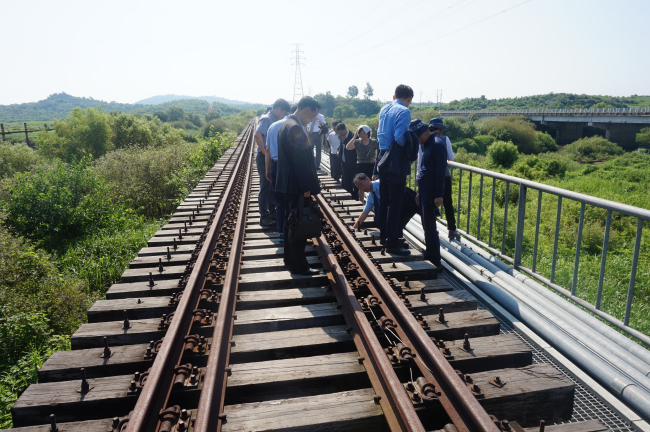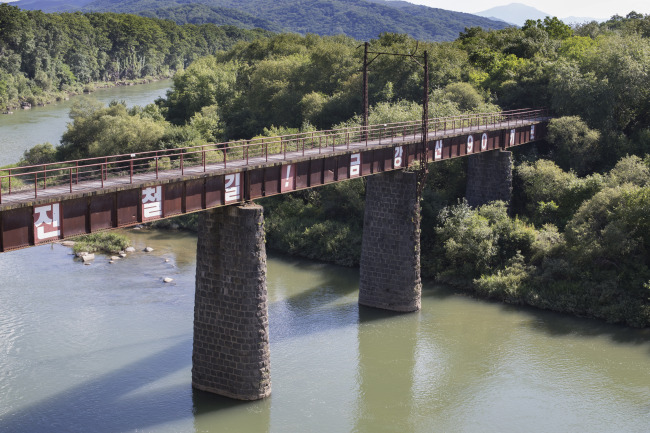S. Korean construction firms eye opportunities for Trans-Korean Railway
By Kim Da-solPublished : Aug. 12, 2018 - 13:59
The Korea Herald is publishing a series of articles featuring inter-Korean relations to mark the paper’s 65th anniversary that falls on Aug. 15. Following is the seventh installment. – Ed.

Under the peace initiative by South Korean President Moon Jae-in, whose pledges include building a Trans-Korean Railway, construction companies are optimistic about the prospect of involvement in the project.
The two Koreas have been working to conduct several rounds of inspections after their leaders agreed during the April 27 summit to modernize the railroads in the North and connect them with those in the South.
If the connection is completed, the route from the Trans-Korean Railway to Europe via the Trans-Siberian Railway will become the longest railroad in the world, at nearly 10,000 kilometers.
It is part of Moon’s envisioned “New Northern Policy,” which seeks new economic engines by expanding Korea’s economic outreach to the northern hemisphere by linking railways, roads, gas pipes and power networks with Russia.
Most recently, the two Koreas have agreed to start a joint survey of cross-border roads this week in a move to modernize and reconnect the North Korean section of the road running from the border town of Kaesong to Pyongyang. Such a joint survey is not a violation to the standing UN sanctions.
Now related companies are eyeing the infrastructure building opportunities in the North.
“The prospect for this overland railroad construction is relatively positive (among industry insiders) as North Korea has fewer hurdles in terms of regulations compared to the South. Also, South and North Korea, China and Europe all have a standardized size of the railroad which can help Korean companies speed up the construction,” said an official from an engineering and construction company, adding that the infrastructure development in the North was good news could help offset slowing economic growth in the South.
Hyundai Group is one of the major companies eyeing the railway project.
In 2000, Hyundai Asan, a key operator of the now-suspended tour program in the North, earned the exclusive business rights for seven major inter-Korean social overhead capital projects, including those for the development of electricity, communication and railroads in the North. The deal is effective until 2030.
With the two Koreas moving to implement a set of arrangements starting with integrating railways, the group has formed a task force to prepare for the possible resumption of its business projects in the North.
Daewoo Engineering & Construction has also formed a separate task force that reviews business projects in the North, expecting that the demand for infrastructure construction will increase for roads, railways and other tourism-based facilities.
GS Engineering & Construction created a North Korea task force, staffed by 10 civil engineering and electrical infrastructure experts, as part of the company’s preparations for market expansion.
Samsung C&T and Daelim Industrial have formed task forces as well.

According to the Construction Association of Korea, deal-making is lethargic in South Korea and more construction firms will shift their focus to the potential of the North.
“For South Korean construction companies, the North is like a new blue ocean market. This will also open up chances for small- and mid-sized companies, not just benefitting the big name builders,” said an official from the Construction Association of Korea.
“The South Korean government should cooperate with China and Russia to establish an integrated rail network and also revise policies, if necessary, so that the investment in railway restoration projects can proceed smoothly considering economic benefits,” he added.
However, hurdles remain in terms of money, effort, and mostly the far-flung negotiations of denuclearization.
According to experts, railroad construction would take a whopping amount of money and time before trains can actually travel up and down the peninsula.
Previous government data have shown that a total of 540 trillion won ($482 billion) is needed to develop infrastructure in the North, while 151 trillion won should be injected to construct roads and railways.
The more sensitive hurdle has come from the controversy over allegations that Pyongyang violated UN resolutions to export coal to the south disguised as Russian coal.
On Friday last week, the Korea Customs Service wrapped up its 10-month investigation into the allegations and referred three firms involved in the coal smuggling to the prosecution. Importing North Korean coal constitutes a violation of the tax law and a breach of the United Nations resolutions banning exports of coal from the North, along with other minerals.
While South Korea and the US governments have said they are working together to deal with the issue, the case could become a major roadblock for the initial stage of connecting and modernizing railroads. The US State Department has warned last week that sanctions would not be lifted for the inter-Korean rail project until North Korea fully gives up its nuclear weapons, according to reports by Voice of America.
Under the UN Security Council Resolution 2375, investments and joint business projects with the North are banned in principle. It only exempts “public utility infrastructure projects” that are non-commercial and non-profit.
The Land, Infrastructure and Transport Ministry has been clear that railway and road cooperation with North Korea will only be implemented when the North’s nuclear problems are resolved and economic sanctions are lifted.
In the meantime, the Moon administration has been moving to prepare business plans within this year on the construction of the railways by forming a special committee on northern economic cooperation.
The Trans-Korean Railway includes three main rail routes, including the Donghae Line along the east coast from Gangneung of the South to Kumgangsan of the North, the Kumgangsan Line in the central areas from Cheorwon to Naegumgang, and the Gyeongui Line through the west of the peninsula from Seoul to Sinuiju.
The Donghae Line is prioritized by the Seoul government as it would be crucial to connect with the Trans-Siberia Railway, to which sections between Rajin of North Korea and Khasan of Russia have already been connected as of 2014.
(ddd@heraldcorp.com)








![[Graphic News] More Koreans say they plan long-distance trips this year](http://res.heraldm.com/phpwas/restmb_idxmake.php?idx=644&simg=/content/image/2024/04/17/20240417050828_0.gif&u=)
![[KH Explains] Hyundai's full hybrid edge to pay off amid slow transition to pure EVs](http://res.heraldm.com/phpwas/restmb_idxmake.php?idx=644&simg=/content/image/2024/04/18/20240418050645_0.jpg&u=20240419100350)






![[From the Scene] Monks, Buddhists hail return of remains of Buddhas](http://res.heraldm.com/phpwas/restmb_idxmake.php?idx=652&simg=/content/image/2024/04/19/20240419050617_0.jpg&u=20240419175937)

![[KH Explains] Hyundai's full hybrid edge to pay off amid slow transition to pure EVs](http://res.heraldm.com/phpwas/restmb_idxmake.php?idx=652&simg=/content/image/2024/04/18/20240418050645_0.jpg&u=20240419100350)

![[Today’s K-pop] Illit drops debut single remix](http://res.heraldm.com/phpwas/restmb_idxmake.php?idx=642&simg=/content/image/2024/04/19/20240419050612_0.jpg&u=)